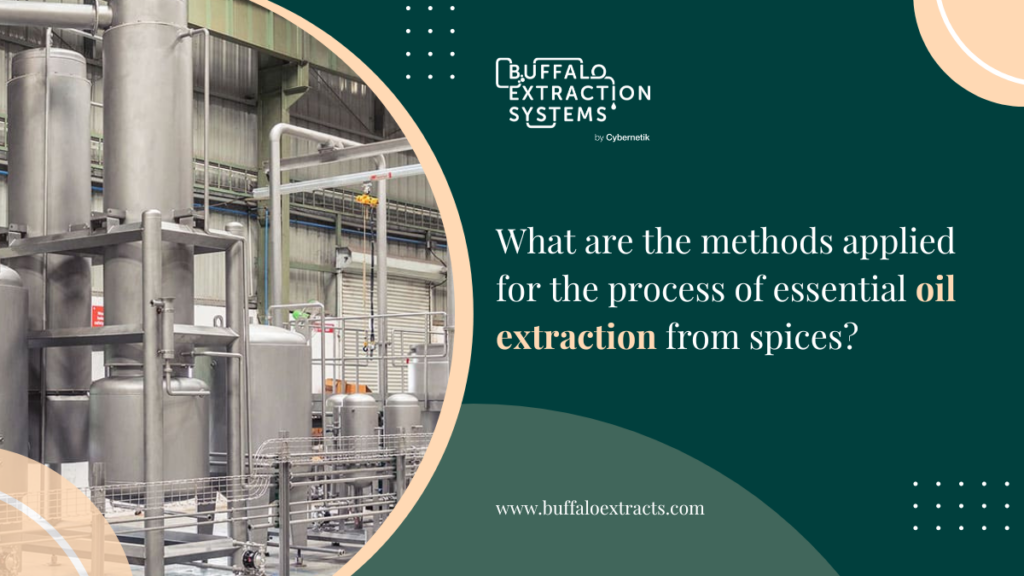Oleoresins: A Nutrient Storehouse
Essential oil extraction from spices such as oleoresins is important in view of the tremendous health benefits that they offer. Oleoresins are a blend of oils and resins. These are naturally available in plants. Oleoresins are mostly used in the feed, personal care, food and beverage, neutraceutical, and pharmaceutical industries. They have a typical aroma and possess attributes that contribute to the taste such as pungency.
Turmeric, herbs, cassia, capsicum, paprika, cinnamon, seed spices, ginger, and turmeric are the major sources of oleoresins. Paprika will continue to remain the most in-demand oleoresin for some time.
Health benefits of oleoresins include their action against:
- Urinary tract infection
- Risk of diarrhoea
- Risk of cancer
- Problems in digestion
- Flatulence
- Rheumatism
- Muscle and joint risks
Oleoresin Extraction: Methods & Considerations
Considerations for the extraction of oleoresins include their vulnerability to:
- Light
- Heat
- Oxidation
Various methods are in use for essential oil extraction from spices such as oleoresins. These include:

- Steam Distillation: This is one of the most commonly used and popular extraction processes for spices. The principle of this process is based on the volatility of essential oils that can be evaporated at low temperatures. The process involves the following steps:
- The spices are placed in a distillation apparatus.
- Steam is passed through the apparatus, and the essential oils are vaporized.
- The steam and vaporized essential oils mixture is passed through a condenser to cool it down, which leaves us with a liquid mixture of water and essential oils.
- The essential oil having lesser density than water floats on top.
- The essential oil is then collected from the mixture, resulting in a concentrated aromatic oil.
- Expression or Cold Pressing: Also known as Scarification, this technique is mainly used in extracting oils from citrus fruits such as oranges, grapefruits, and lemons. Steps include:
- The peel of a citrus fruit is pressed mechanically, using a machine.
- The oil-containing gland is ruptured during this process due to the pressure applied, releasing the essential oil.
- The oil released is then collected in a container or vessel.
- Further impurities are removed from the oils by undergoing processes such as filtration, etc.
- Solvent Extraction: The process is used when other processes such as steam distillation are not suitable for some spices. Solvents used in this process are mostly food-grade alcohol or hexane. Procedure is as follows:
- The spice is soaked in the solvent so that the essential oils are dissolved in the solvent.
- The mixture of solvent and oil is separated from the solid residue, using the process of centrifugation or filtration.
- The solvent is then evaporated, to leave behind the essential oils.
- Supercritical Fluid Extraction (SCFE) using Carbon dioxide (CO2): Carbon Dioxide Extraction also known as Supercritical Fluid Extraction Process is a modern technique in which essential oils are extracted using carbon dioxide in its supercritical state. Operational procedure involves the below steps:
- Carbon Dioxide is transformed to its supercritical state where it behaves both as a liquid and a gas. Conditions are a temperature of 31.1°C and 73.9 bar pressure.
- Supercritical carbon dioxide is passed through the spice raw material so that it dissolves the essential oils.
- Carbon dioxide is then depressurized to revert to its gaseous form.
- At low pressure, the essential oils separate from carbon dioxide. Essential oils are collected separately, while the carbon dioxide is sent for reuse.
- Enfleurage: Is a method used since ancient times to extract delicate floral essential oils from petals and flowers. This method is rarely used at present but is one of the oldest methods that uses fats. Steps in the process include:
- Spice material from which the essential oils are to be extracted is spread over an odorless fat such as vegetable oil or lard, on a plate or glass.
- Essential oils are diffused in the fat over time leaving behind its fragrance and constituents.
- This process is repeated until the fat is saturated with essential oil.
- Alcohol is then used to wash the fat and extract essential oils.
- Next, alcohol is evaporated to leave behind the essential oils.
- Another variant of Enfleurage is Hot Enfleurage where the fat is heated.
Advantages of Supercritical Fluid Extraction (SCFE)
On account of the pressure difference technique involved in SCFE, the quality of the extract is pure. This makes it a valuable method for essential oil extraction from spices such as oleoresins.
At high pressure, when carbon dioxide is in its supercritical state, it dissolves the essential oils from the raw material. And at low pressure, it allows the essential oils to separate out. No carbon dioxide residues are found in the extract. Residues of other elements from the raw material are quickly and easily removed during post processing.
Besides, carbon dioxide is readily available, is non-flammable, and economical. When recycled, it does not pollute the air around. For these reasons, CO2 SCFE is preferred for the extraction of oleoresins.
Conclusion
Extraction of essential oils from spices involves various methods. Each process is suited for different types of plant material and desired outcomes. Solvent extraction, SCFE (CO2 extraction), Effleurage, Steam distillation, and Expression or cold pressing are some of the most commonly used techniques. Factors such as desired yield, industry requirements, the quality of essential oil, and the nature of spice affect the selection of extraction methods. Due to its capability to produce a pure extract of essential oils, SCFE is preferred over other extraction methods.
ALSO, YOU CAN READ OUR NEW UPDATES
Check Out These Types of Cannabis Oil Extraction Equipment Before You Select Yours
What is the Significance of Cannabis Oil Extraction Equipment?
Here’s a Comprehensive Guide on Spice Oil Extraction that You Must Check Out
CO2 Extraction for Cosmetics: What is the Role of CO2 Extracts?

